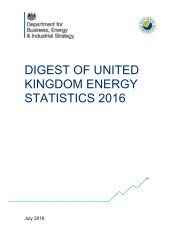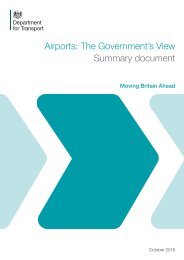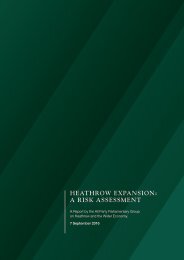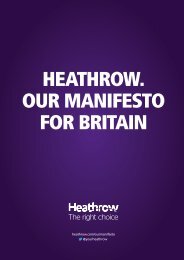20131211-2013.12Reports
20131211-2013.12Reports
20131211-2013.12Reports
Create successful ePaper yourself
Turn your PDF publications into a flip-book with our unique Google optimized e-Paper software.
The Rules of the Air 2007, Rule 11 states that:<br />
(1) ...an aircraft which is being overtaken in the air shall have the right-of-way and the overtaking<br />
aircraft, whether climbing, descending or in horizontal flight, shall keep out of the way of the other<br />
aircraft by altering course to the right.<br />
(2) An aircraft which is overtaking another aircraft shall keep out of the way of the other aircraft<br />
until that other aircraft has been passed and is clear, notwithstanding any change in the relative<br />
positions of the two aircraft”.<br />
The Manchester METAR 1120 was:<br />
18010KT 150V220 9999 FEW 018 SCT 028 24/18 Q1008 NO SIG=<br />
PART B: SUMMARY OF THE BOARD’S DISCUSSIONS<br />
Information available included a report from one of the pilots involved and a radar video recording.<br />
The Board were disappointed that the pilot of the Mooney M20 had not responded to several<br />
requests to complete an Airprox report. Consequently, it was not possible to determine whether he<br />
had ever obtained visual contact with the EV97. However, in view of the weather conditions reported<br />
by the EV97 pilot (CAVOK) there was no reason, from a weather perspective, that he should not have<br />
been able to see the other aircraft.<br />
The Board were mindful of the fact that the sole objective of the UKAB is to assess reported Airprox<br />
in the interests of enhancing flight safety; it is not the purpose of the Board to apportion blame or<br />
liability even if one pilot chooses not to participate in the process. Although both pilots were equally<br />
responsible for collision avoidance in Class G airspace (Rule 8), lacking any further evidence from<br />
the Mooney pilot, the Board concluded that the M20, being faster than the EV97, was overtaking the<br />
latter aircraft at the time of the Airprox. Therefore, they opined that the M20 pilot had every<br />
opportunity to see the EV-97 and should simply have kept out of its way (Rule 11). As a result of this<br />
the Board decided that the cause of the Airprox was that the M20 pilot flew close enough to the EV97<br />
to cause its pilot concern.<br />
Once the cause had been determined, considerable discussion then took place about whether the<br />
risk should be classified as a Category B, C or D. Members decided that, although there was no<br />
report from the M20 pilot, and so they could not ascertain what he had or had not seen, there was still<br />
sufficient evidence from the radar recordings and the EV97 pilot’s report to render a meaningful<br />
finding. If the M20 pilot had not seen the EV-97 then safety margins had been much reduced<br />
because the two aircraft had come within 100ft vertically and < 0.1nm. If the M20 pilot had seen the<br />
EV-97 then he had flown too close and had disregarded the requirement to pass by on the right of the<br />
EV-97, thereby also reducing safety margins below normal. Therefore, in either case, the Board<br />
decided that the M20 had passed sufficiently close to the EV97 (recorded as 100ft V and







